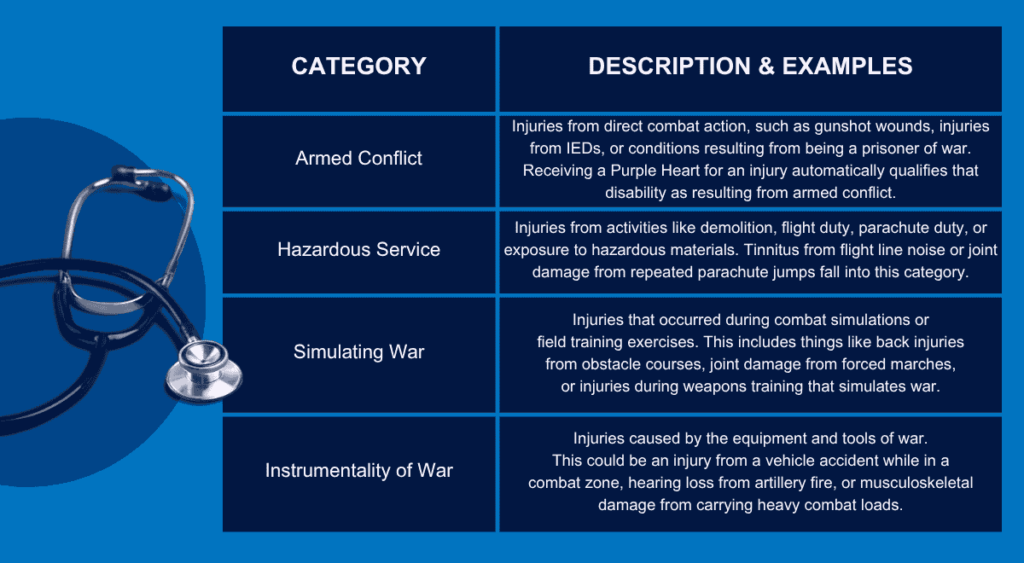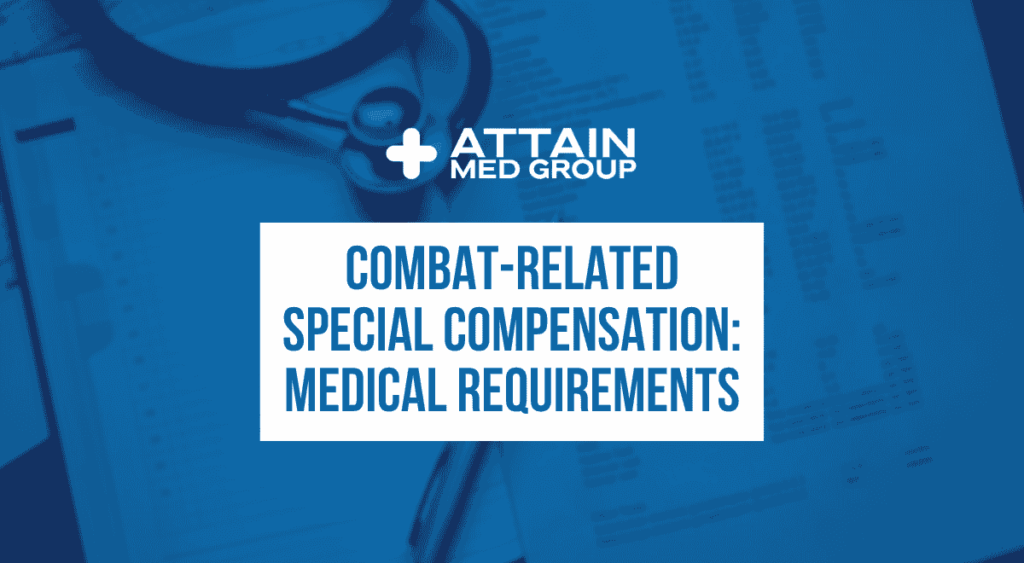If you are a military retiree with a disability from your time in service, you have likely heard of Combat-Related Special Compensation (CRSC). You might also be looking at a pile of paperwork, feeling completely overwhelmed. This process can make you feel like the government has created a secret code you must crack to get the benefits you earned.

You are not alone in feeling this way, and understanding how to build a strong case is the first step. You will learn how to explore how CRSC VA medical evidence and a strong doctor’s statement impact eligibility for Combat-Related Special Compensation. The process is not just about filling out a form; it is about telling a story with evidence to support your CRSC claim.
This story is about what happened to you and how it still affects you today. Getting this right is critical, which is why it is vital to understand the roles of medical proof and expert opinions. It is about connecting the dots for the people at your service branch who review your file.
What is Combat-Related Special Compensation (CRSC)?
First, let’s clear up a common point of confusion. CRSC is not a VA benefit. It is a Department of Defense (DoD) program that allows eligible military retirees to receive both their military retired pay and their VA disability compensation.
Normally, federal law requires a dollar-for-dollar offset through a VA waiver. This means for every dollar you get from the VA for a disability, a dollar is taken from your retirement pay. CRSC is one way to restore that military retired pay, offering a tax-free payment to those who qualify.
To meet the basic eligibility criteria, you must be a military retiree and have a VA disability rating of at least 10 percent. Most importantly, your disability must be considered combat-related. This last part is where things get tricky, and where your required evidence becomes everything for getting your special compensation.
The Foundation of Your Claim: VA Medical Evidence
Think of your medical evidence as the concrete foundation of a house. Without a solid foundation, everything else will eventually fall apart. For your CRSC application, this foundation proves that your disability is real and ongoing.
Your evidence needs to show a clear line from your time in service to your current health issues. The board reviewing your case wants to see documentation that makes the connection obvious. Let’s look at the types of evidence support you will use to build your case for CRSC benefits.
Service Treatment Records (STRs)
Your Service Treatment Records are the single most important pieces of evidence you have. These military records are from your time on active duty. They are a firsthand account of what happened to you while you were in uniform.
A note in your STR about being treated for a back injury after a hard parachute landing is gold. A record of visiting sick calls ringing in your ears after weapons training is powerful proof of your combat-related disabilities. This documentation provides a timestamped account that is hard to dispute.
But what if you never went to sick call? Many of us were taught to just push through the pain, so it is common to have thin STRs. Do not worry, as this does not mean your claim for this special compensation is dead in the water.
Post-Service Medical Records

If your STRs are light on details, your medical records since leaving the military become much more important. This includes all your VA medical records and any records from private doctors. These documents show the continuity of your condition and are critical for seeking CRSC.
Maybe your knees started hurting in the Army, but you just took Motrin and kept going. If you saw a doctor for knee pain a year after you got out, that record helps bridge the gap. Consistent treatment records over several years for the same issue create a strong paper trail that the reviewers cannot ignore.
This ongoing log of medical care demonstrates that the injury occurred during service and has persisted, impacting your life long after you took off the uniform. These records VA has on file and any you provide directly strengthen the link between your past service and current disability payments.
Connecting Your Disability to Combat: The Critical Link
This is the heart of the matter. Your medical records prove you have a condition, but how do you prove it is combat-related? The DoD has a specific definition for what qualifies under the requirements CRSC lays out.
A disability can be considered combat-related if it was sustained in one of four ways. Your job is to use your evidence to place your injury squarely into one of those categories. This is how you explore how CRSC VA medical evidence and a strong doctor’s statement impact eligibility for Combat-Related Special Compensation.
For example, hearing loss from working on a flight line is an injury from hazardous duty. PTSD from a rocket attack is a direct result of armed conflict. A strong doctor’s statement, often called a nexus letter, becomes your most powerful tool in making this connection clear.
The medical evidence shows the “what” (your injury). The doctor’s statement explains the “how” and “why” it’s connected to your military service in a combat-related way. This opinion helps the board understand the context of your injury.
Understanding “Combat-Related” Categories
To build a strong case, you must show how your injury fits into the DoD’s specific definitions. The Defense Finance and Accounting Service relies on your service branch to make this determination based on your evidence. Here are the categories the DoD uses to define combat-related disabilities.

What Makes a Doctor’s Statement Strong?
A note from your family doctor saying “his back probably hurts from the military” will not cut it. A strong statement is a detailed medical opinion written by a qualified professional. It connects all the dots for the person reviewing your CRSC application, leaving them with no questions.
It acts as a professional translation of your experiences and medical history. The doctor analyzes the facts and gives a medical judgment on the cause of your disability. Without this, the reviewer is left to make their own assumptions, which may not be in your favor when they determine your CRSC eligibility.
A detailed letter provides the rationale needed for the board to approve your special compensation CRSC claim. It transforms a collection of medical facts into a compelling argument. This professional opinion adds significant weight to the evidence support you provide.
Key Elements of a Powerful Doctor’s Statement
A good doctor’s statement or nexus letter should follow a specific format to be most effective. It needs to contain several key components to carry weight with the DoD review board. Here is what the best ones include.

This detailed statement provides a professional medical opinion that supports your claim. It explains things in a way that is hard for the review board to dispute. The right letter can make the difference between approval and denial.
Navigating the CRSC Application and Eligibility
Once you have gathered your evidence, the next step is the dd form 2860, the CRSC application. Each service branch, including the Army, Navy, Air Force, Marine Corps, and Coast Guard, has its own process for submission. It is important to send your completed packet to the correct address for your branch of service.
Eligibility can sometimes be complex, especially for veterans who were medically retired. Whether you are on the temporary disabled retirement list (TDRL) or the permanent disability retired list (PDRL), you may be eligible. Even those on a temporary disabled retirement plan should investigate their options.
Your retirement orders and the reason you were placed on the disabled retirement list are important pieces of information. For those on a permanent disability retired status, CRSC can be a crucial financial benefit. The key is to demonstrate the combat-related nature of the condition that led to your disability retired status.
Putting It All Together: An Example

Let us imagine a Marine who served in Fallujah. During a patrol, a car bomb detonates nearby, throwing him against a wall. His STRs show he was evaluated for a concussion and back pain right after the blast.
He gets out of the military, and his back pain gets worse over the years. He also develops constant ringing in his ears (tinnitus). He gets a 40% VA rating for his back and a 10% rating for tinnitus, but his dod retirement payments are being reduced because of the VA offset.
To file for CRSC, he gets his service records together. They show consistent treatment for his back and tinnitus for a decade after his service. The key piece of his packet, however, is the nexus letter from his orthopedic doctor.
The doctor’s letter states he reviewed all the Marine’s military records, including the entry about the car bomb. The doctor then writes, “It is at least as likely as not that the veteran’s current lumbar spine condition and tinnitus are a direct result of the concussive force and trauma experienced during the car bomb explosion, an instrumentality of war, in Iraq.” This is the kind of clear, powerful connection the CRSC board needs to see to approve disability pay restoration.
Upon approval, his CRSC payment would begin, and he would also be eligible for retroactive pay. The retroactive payment could go back to his retirement date or the date of the law’s enactment, whichever is later, up to a statutory limit. This compensation CRSC provides is a significant benefit for eligible veterans.
Conclusion
Building a successful CRSC claim takes time and effort. It requires you to be a detective, piecing together the story of your injury using official documents and expert medical opinions. This process helps restore your full military retirement pay without the VA offset.
Your medical evidence lays the foundation by proving your disability. A strong doctor’s statement then builds the walls by directly linking that disability to a combat-related event. They are not just papers; they are the voice that proves your case.
When you explore how CRSC VA medical evidence and a strong doctor’s statement impact eligibility for Combat-Related Special Compensation, you see their combined power. Together, they create a complete and persuasive picture for the review board, helping you secure the full benefits you have rightfully earned through your service and sacrifice. This makes understanding the eligibility requirement and providing the right evidence so important.

